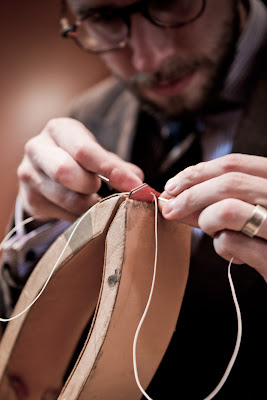As mentioned in the first part of this Hermès series, artisan Claire Marie was kind enough to allow me to try stitching part of the clochette that she was making. As with previous attempts at being hands-on, it of course all went wrong.
It’s easy to watch demonstrations of stitching or cutting and think that the act itself is not that difficult. What is hard is maintaining concentration as the act is repeated, and making small adjustments as the surface of the leather, silk or worsted changes.
That is probably true when one is trained and the fundamental processes of your craft have become virtually automatic. But it takes a long time to get there. Under Hermès training in Paris, everyone has a qualification in leather working when they join but still spends a whole month just learning about their tools, and the next few weeks just repeating the kind of saddle stitching I attempted here.
The saddle stitch, as explained in the previous post, requires two needles to pass through the same hole, with an awl first piercing that hole and guiding the first needle through. It is this process of guiding the needle back that proved tricky for me.
The temptation is to bend your head down and look at the underside of the leather, to see where the needle has to go. But if you do this every time it takes too long and is very hard on the back. Pushing the needle and pulling the awl at the same time is not, however, very intuitive.
I think I managed it on the fifth or sixth attempt. By that point I was sweating and my teeth were gritted. It felt like a minor milestone. Claire was kind, saying it was more difficult than it looked and that the pincer that holds the leather was clearly the wrong size for me.
I think I’ll stick to writing, and appreciating leather from afar.
Photography: Andy Barnham
































